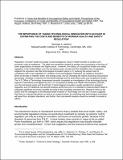| dc.description.abstract | Abstract
Regulation of worker health and safety is acknowledged to result in health benefits to workers and
economic costs to employers. The latter are sometimes shared by workers and consumers in the form of
lower wages/salary increases and higher prices. However, the history of occupational health and safety
regulation in the United States over the last twenty years reveals that this simplified view of regulation
neglects the important role that technological innovation plays in (1) reducing the actual costs of
compliance with a new regulation to a fraction of pre-promulgation estimates, (2) yielding a benefit in
terms of savings in material, water, and energy costs, and (3) changing the nature of process and product
technology, resulting in reduced environmental damage and its associated costs and compliance burden.
The U.S. Office of Technology Assessment recently completed an investigation of the technology-forcing
aspects of standards promulgated by the U.S. Occupational Safety and Health Administration (OSHA)
over the last twenty years and found that (1) technological innovation usually resulted from stringent
regulation and (2) traditional cost-benefit analysis performed prior to a standard's implementation failed to
anticipate significant economic benefits accruing to the innovating industrial firm. Research done by the
author and his colleagues at the Massachusetts Institute of Technology over the last 15 years suggests
that there is a strong theoretical, as well as an empirical basis, for predicting that technological innovation
will result from stringent standards, and further, that cost-benefit analysis should be revised to include its
effects | en |
